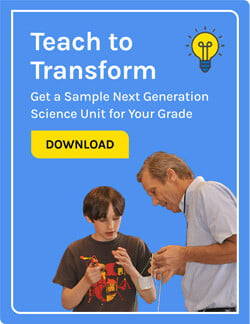 Students will not start out with the ability to use science and engineering practice skills. That’s why we put so much emphasis on a gradual release of responsibility and on helping students become independent in their use of these ideas.
Students will not start out with the ability to use science and engineering practice skills. That’s why we put so much emphasis on a gradual release of responsibility and on helping students become independent in their use of these ideas.
We do this in the context of other disciplines – English language arts, math, technology – and by introducing students to the science and engineering practices while requiring them to function with increasing levels of independence is key to mastery.
The tradition of siloed instruction – each subject taught on its own without integration – really has no home with NGSS. NGSS by design treats science as a basic discipline integrated with others, even at a very young age. That’s why you see these students taking on the role of engineers but using their knowledge of science to solve a problem in their own way.
You can see in the photo above that we start early; these students are in second or third grade, and already operating independently in the roles of scientists and engineers. Come fifth or sixth grade, those practice skills deepen, and the environment changes from one with a lot of structure and guidance to one where inquiry is much more open. Students may still use templates or work within a templated process, but are free to take a more individualized approach.
And so it goes, at each grade level and for each month that students move through the school year, they’re able to take more ownership over the science or engineering process. In your curriculum, you need to think about how you are ushering students at every grade level to proficiency in the practices, and then pushing the expectation, and extending their understanding once they have met those expectations.

So how much time are you actually spending? Well, the time-on-learning for science will vary by grade:
- Kindergarten through 2nd grade is about an hour and 45 minutes a week
- 3rd through 5th grade is about 2 and a half hours
That's not a continuous block, of course, but is broken up over multiple days.
- In 6th through 8th grade, you're looking at roughly a 55-minute-a-day model. If you have larger blocks of time, you can do three hours and 45 minutes in aggregate. Oftentimes, waterfall scheduling allows for that where you might have hour and a half blocks a couple of times a week, but that's it.
Then that continues into high school in most cases. Now, with No Child Left Behind, the focus for most people has turned to ELA and math, and out the window went science and social studies, as well as art, music and a lot of other things. It's not uncommon that a lot of people don't do that two and a half hours time on learning. They try to do 15 minutes or 30 minutes at the end of the day on Wednesday or Friday.
But if critical thinking is a priority, if practice skills are a priority and if moving students' standardized test data up in science is a priority, that approach needs to change.
The great thing is that by changing that, you are not just going to benefit science, you're going to benefit math and ELA because – at least in our case when students are engaged in what we offer – the Common Core ELA and math practices come alive, and that makes a huge difference for ELA and math because students are actually applying relevant, hands-on learning.



